Spyglass Beef Research Facility
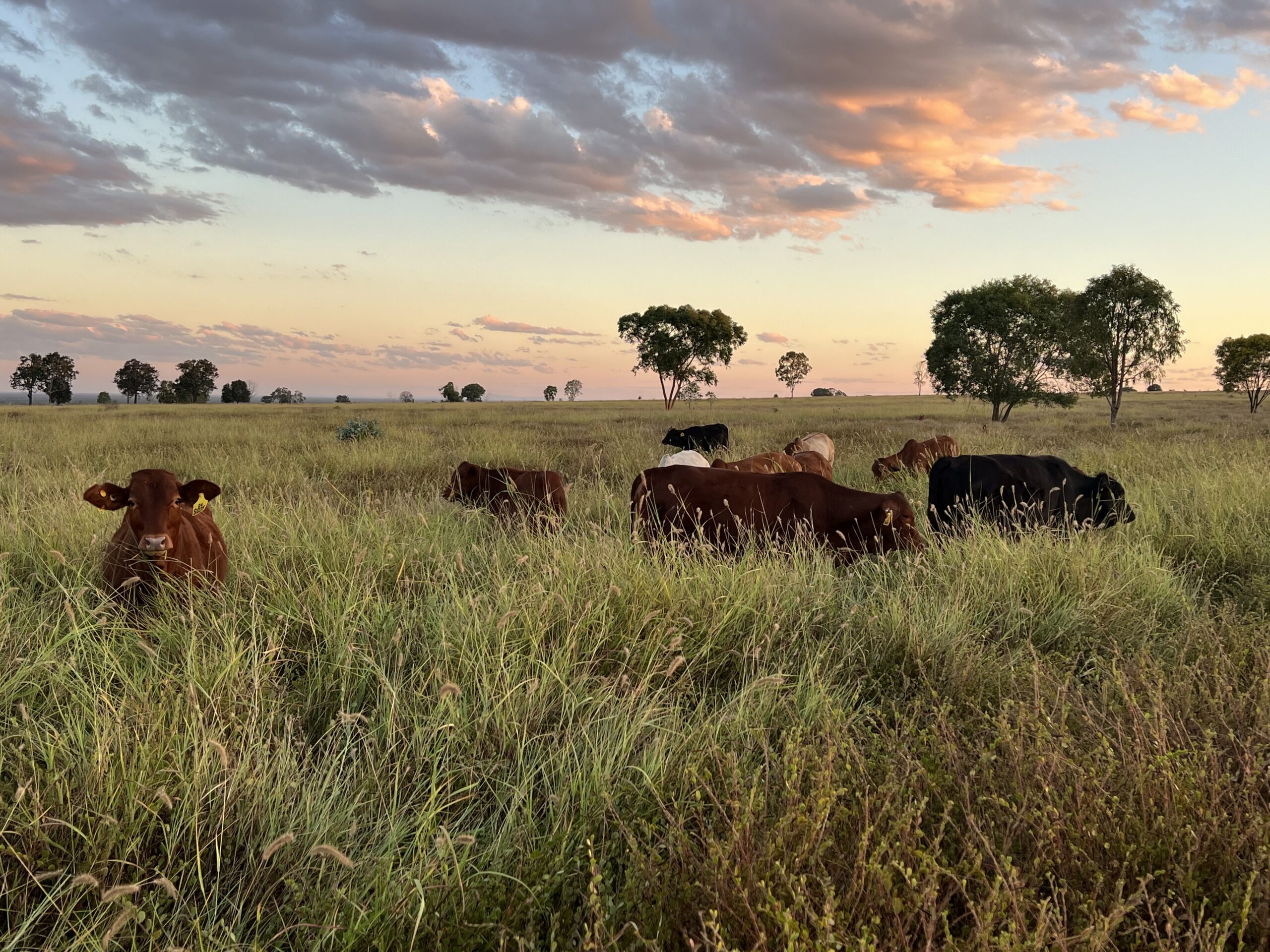
Spyglass Beef Research Facility, or ‘Spyglass’, is owned and operated by the Queensland Department of Primary Industries (DPI) in the Charters Towers Regional Council area and is typical of an extensive breeding property in North Queensland. The research facility covers 38,221 hectares (94,446 acres) and is located approximately 110 kilometres north of Charters Towers and 130 kilometres west of Townsville via the Hervey’s Range Road.
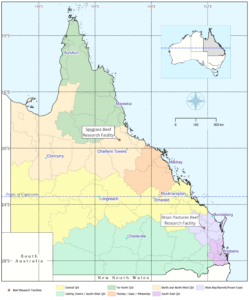
Spyglass receives an average annual rainfall of 711 mm (2003-2024) with 80% falling between October and March each year. The rainfall ranges from 1148 mm in wet years (2010) and 257mm (2015) in dry years.
The land types on the station vary from lancewood and ranges through to loamy alluvials and softwood scrub. For more information on the land types download the full map at Landtypes at Spyglass. The property has over 13 kms of Burdekin River frontage and pasture largely consists of native species with small areas of improved pastures on the more fertile land types. It has a carrying capacity of approximately 3500 head of adult cattle.
Long-term land and pasture monitoring systems (more than 25 years) have been established. These will be used to validate the impacts of grazing strategies and climate change on pasture and animal production, landscape condition and business performance.
The work undertaken by DPI and our collaborators at Spyglass Beef Research Facility aims to increase productivity, profitability and sustainability for beef producers by addressing key industry research and development questions. These include topics such as beef cattle genetics, reproduction, growth, welfare and husbandry, as well as effective grazing management and gully remediation. Key current examples of this research work are ongoing identification and validation of improved beef cattle genetics. Others are investigations into the causes of, and solutions for, reproductive inefficiencies such as embryo and newborn calf loss, using real data from the facility to inform industry understanding. The facility provides ongoing extension opportunities, with events and field days held regularly to provide updates on research and to promote best practice land and cattle management.
Where it started…
The purchase of two adjoining properties in 2011, Spyglass and Lucky Break, formed a key part of the Queensland Government’s ‘2020 Beef Plan’. Industry leaders from AgForce, Northern Australian Beef Research Committee (NABRC), Meat and Livestock Australia (MLA) and Cattle Council, together with Departmental officers from Brisbane, Nambour, Rockhampton and Charters Towers conducted assessments on 15 Upper Burdekin properties, and recommended the purchase of the Spyglass and Lucky Break aggregation. The two properties were purchased for $10.1M and form what is now referred to as ‘Spyglass’. Handover of the properties occurred two days before Cyclone Yasi crossed the north Queensland coast in February 2011.
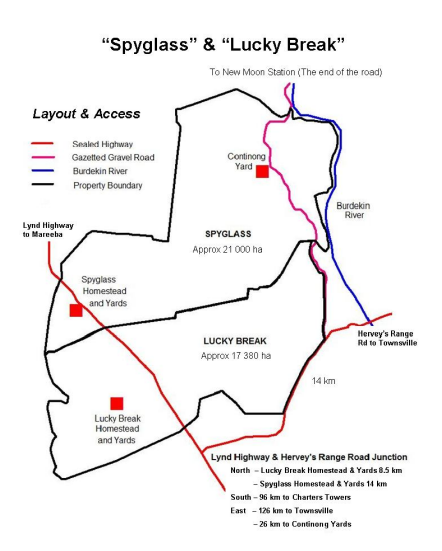
Spyglass welcomed its first herd of cattle in 2012 when nearly 500 weaner breeders moved from the department’s former Swan’s Lagoon Research Station near Ayr. These cattle formed part of one of Australia’s longest running genetics projects, with intensive recording (which at the time) spanned 12 years. They would form the core of the new station’s breeding herd, with 2000 more head of cattle moved to Spyglass within the following six months.
In the following years there has been considerable ongoing investment to transform operating commercial cattle properties into a ‘research ready’ facility with controlled environments suitable for running trials and experiments. This included by establishing or improving fence, yard and water infrastructure, and building staff accommodation, visitor quarters and an office to allow staff to live and work at Spyglass. The office facilities are located close to the original Lucky Break homestead.
An industry advisory committee was established in late 2013 to provide advice and recommendations and plays an important role in the ongoing running of the facility. The industry advisory committee consists of 8 to 12 people, and they meet on site every year.

Current facilities and equipment
With the majority of major upgrades completed, Spyglass is well developed in terms of infrastructure and equipment for a research facility.
The Research facility now has:
Paddocks
- 10 larger paddocks – 1000 hectares+
- 4 medium paddocks – 500 to 1000 hectares
- 19 smaller paddocks – 100 to 500 hectares
- 15 holding paddocks – 20 to 100 hectares
- 4 paddocks of marginal/heavily timbered lancewood country on the eastern side (approx. 2210 hectares) is fenced out.
The majority of the property has a maximum distance of 2 kilometres to a water source for cattle.
Infrastructure
- 2 sets of 5-way hydraulic auto draft yards (1500 head capacity each)
- Extensive plant and equipment to support research activity
- Various remote weather stations, cameras and tank monitors
- Extensive onsite hay, dry lick and molasses storage facilities
- Paddocks with controlled waters to improve research opportunities
- Sample preparation room and secure onsite chemical storage container
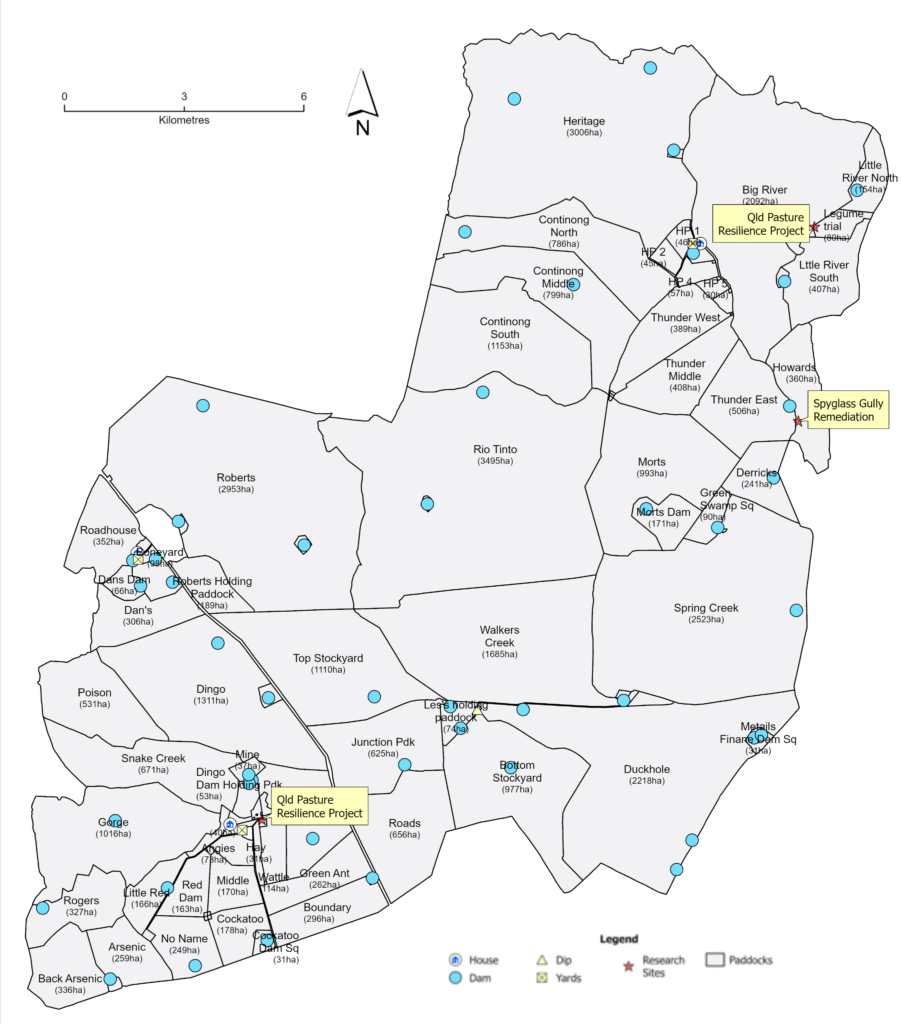
Spyglass has a large herd (principally Droughtmaster and Brahman cattle, plus some Santa Gertrudis for research purposes) with an extensive genetic history available for research use, plus an extensive paddock and livestock recording system which includes genotypic and phenotypic animal traits.
While the work undertaken at Spyglass is relevant to northern commercial cattle production, cattle at the facility are managed to meet the specific requirements of the individual research projects rather than only on a commercial basis.
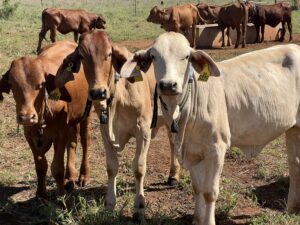
Current Staff
The team at Spyglass currently consists of 9 people living on site. These work either on the property (in terms of management or every day operations) or in the various projects. With staff visitor quarters on site, the property also hosts many visiting guests throughout the year.
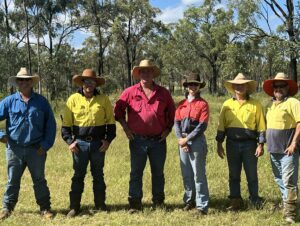
Research Projects
There are currently various scientific trials and demonstration sites on Spyglass. Work conducted on Spyglass to date includes but is not limited to the following projects:
Repronomics Trial
Accelerated genetic improvement of female reproduction in tropical beef cattle breeds. The project is led by David Johnston and Tim Grant. Tim.Grant@dpi.qld.gov.au
Pain Relief
Investigating the welfare and production benefits of providing pain relief to calves at castration and dehorning. The project is led by Jarud Muller. Jarud.Muller@dpi.qld.gov.au
Superior Tropical Grasses
The tropical forages collection, held within the Australian Pastures Genebank (APG) is the principal resource for developing new pasture and fodder plants in Australia. This project is the next phase of a periodically reviewed program to regenerate (low viability or number) seed stocks and characterise tropical forage accessions (unique lines). The activity is conducted at DPI Walkamin with priority on taxa for Australian agriculture, particularly the beef, dairy and sheep industries. Approximately 170-190 accessions are grown out each year. The project is led by Kendrick Cox. Kendrick.Cox@dpi.qld.gov.au
Spyglass Sown Pasture Experiment – Leucaena and legume replicated paddocks
This 5-year project includes on-property field trials and on-farm demonstrations to address key gaps in producer knowledge and promote the adoption of pasture legumes in the seasonally dry zone of north Queensland. The on-property activities will be integrated with a range of extension activities to improve producer and advisor decision-making capacity and maximise adoption of improved pasture management systems overall. The project is led by Kendrick Cox. Kendrick.Cox@dpi.qld.gov.au
The effect of diet quality on milk delivery to newborn calves & Variation in milk delivery to tropically adapted newborn calves
Two research projects investigating low milk delivery and dehydration as a cause of calf mortality in northern Australia. Within approximately 200 calves, the percentage of calves with low uptake will be determined. In addition, the reasons for low milk delivery will be investigated where possible. The project is led by Jarud Muller. Jarud.Muller@dpi.qld.gov.au
The effect of strategic supplementation on colostrum secretion, calf health and growth
The project aims to demonstrate how increased protein nutrition for cows in late pregnancy results in higher milk delivery to and survival of newborn calves, and to provide an understanding of the cow hormones involved. The project is led by Jarud Muller. Jarud.Muller@dpi.qld.gov.au
SWIFTSYND sites and pasture modelling
This project will deliver a combined program of new pasture modelling research and end-user review and evaluation of Long Paddock and FORAGE products to provide relevant and valued information to assist the Queensland grazing industry to adapt and manage for a variable climate. This project is led by Raj Pandeya. Rajhemant.Pandeya@dpi.qld.gov.au
Indian Couch Trial
This project will collect groundwork data to describe the extent of Indian couch invasion in tropical pastures. The project will also investigate the mechanisms for invasion, quantify production impacts of Indian couch, and test different control and management options. Project led by Nicole Spiegel. Nicole.Spiegel@dpi.qld.gov.au
Assessment of promising legumes and grasses
Developing trials with the aim of evaluating different sown pasture legumes and grasses for suitability in North Queensland. This project is led by Kendrick Cox. Kendrick.Cox@dpi.qld.gov.au
Spyglass Gully Restoration
The project seeks to improve understanding of cost effective alluvial gully remediation techniques, increase the knowledge and skill base for gully remediation in the Upper Burdekin, and reduce sediment generation from a gully network at the mouth of Continong Creek. The project is led by Simon Hunt. Simon.Hunt@dpi.qld.gov.au
Virtual fencing used as a tool for land and pasture management
The Virtually Fence Free project (led by NQ Dry Tropics) will use virtual fencing technology, informed by a range of monitoring strategies including walkover weighing systems, faecal NIRS testing and land condition monitoring, to determine the most drought-resilient grazing systems and pasture varieties to maximise production and welfare, while reducing landscape vulnerability to deteriorating conditions. The five-year trial will take place at Spyglass Beef Research Facility, in the Upper Burdekin north of Charters Towers. The only Northern Australian trial, it will test the viability of virtual fencing systems in remote rangeland environments. The results will help shape and promote wider adoption. The project is led by Marc McConnell from NQ Dry Tropics.
Producer Demonstration Sites
Demonstration of how annual steer growth could be used as an indicator of the productivity potential of breeders using the Spyglass research ready herd cows
Provide a simple, low input demonstration using annual steer live weight gain to determine if a cow herd is producing to at the environment’s potential. INNOVATION Annual steer growth as indicator of productivity potential of breeders using Spyglass commercial herd cows. Project led by Dave Smith. Dave.Smith@dpi.qld.gov.au
Demonstration of the effect of heifer live weight on subsequent pregnancy at Spyglass using research ready herd heifers
PDS to demonstrate the effect of live weight on heifer pregnancy rates in northern Queensland. Low pregnancy rates in 2 year old heifers in NQ are common. Typically it is due to heifers going into the mating period under weight and subsequently not reaching target mating weights until the end of mating or after. In many cases producers appear perplexed when their well grown heifers presented at pregnancy testing often return poor pregnancy rates. Project led by Dave Smith. Dave.Smith@dpi.qld.gov.au